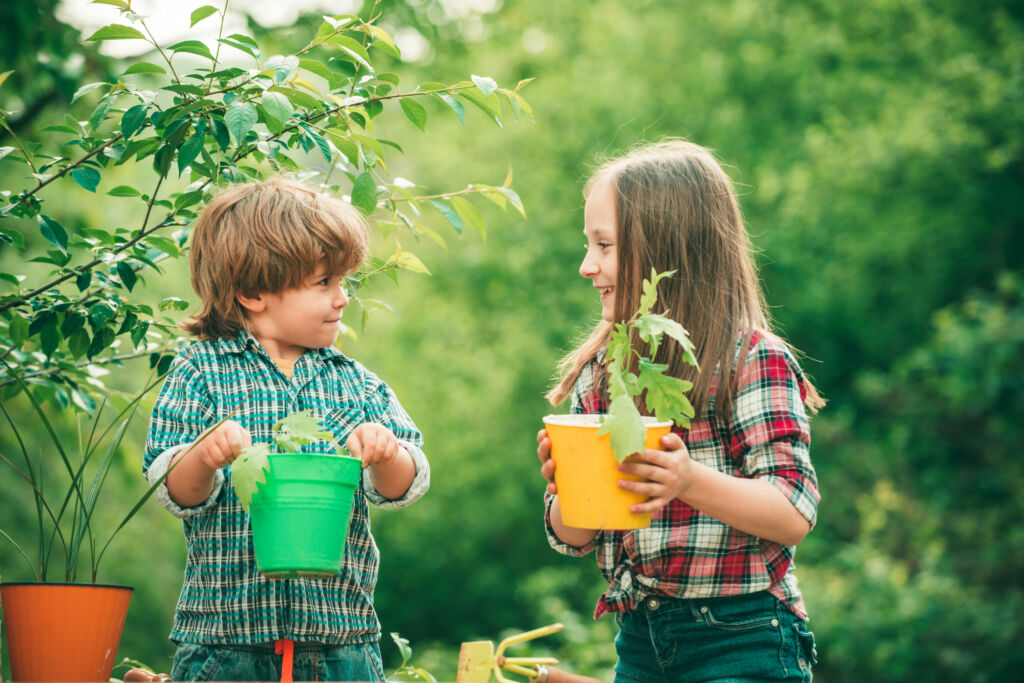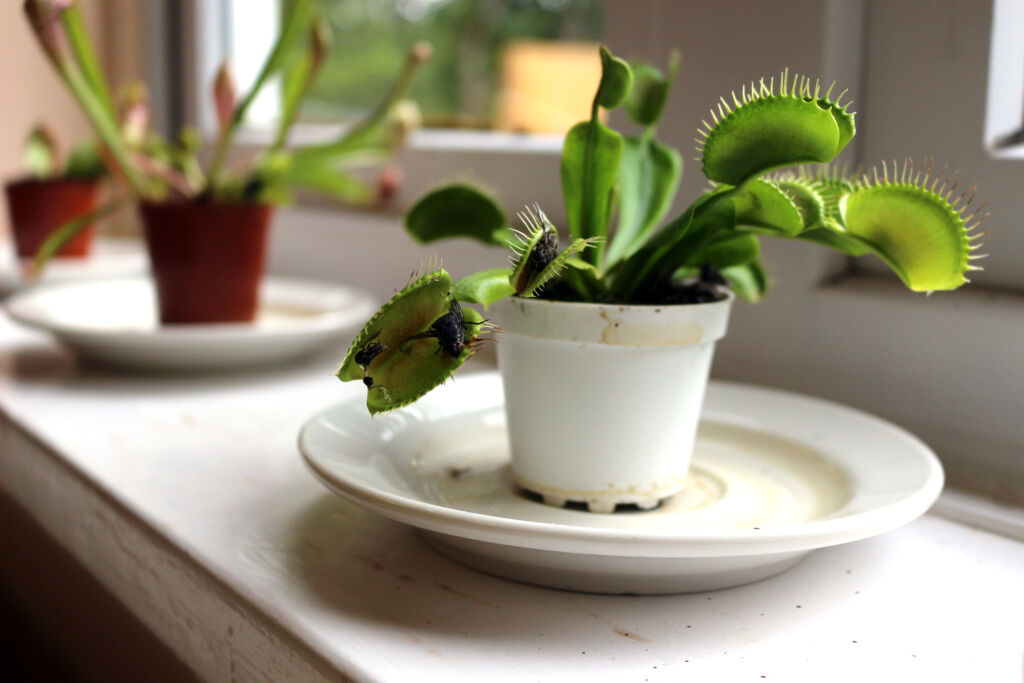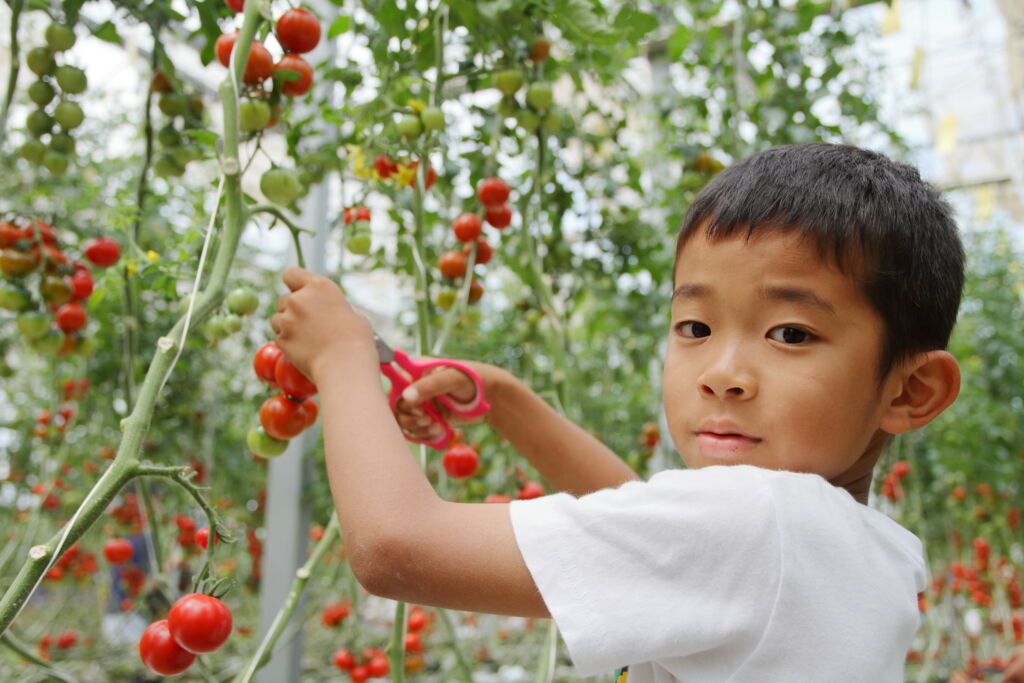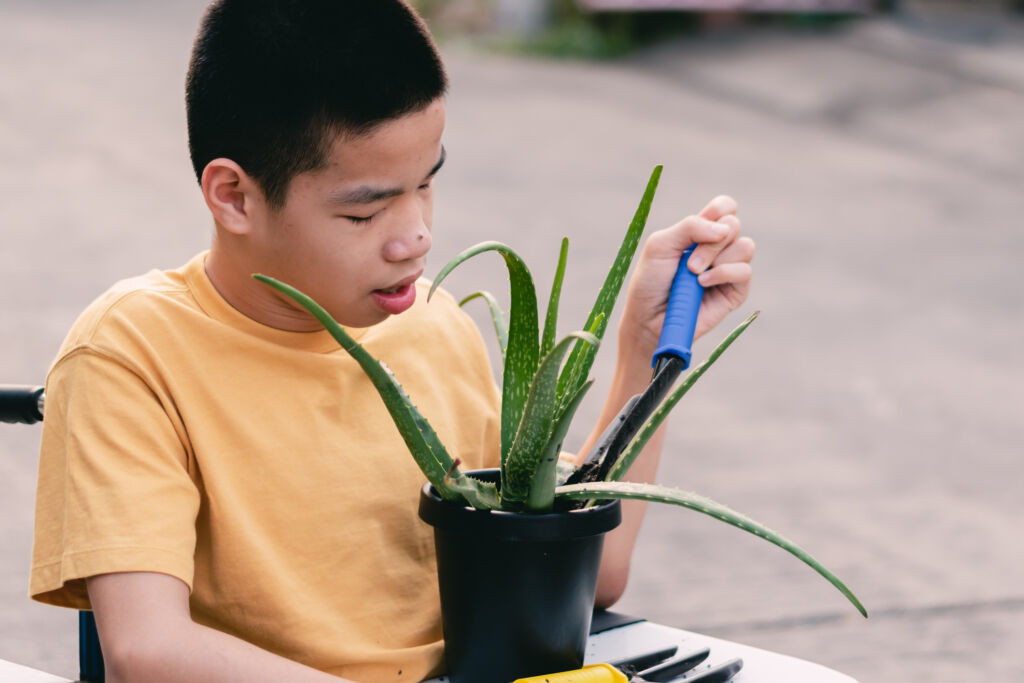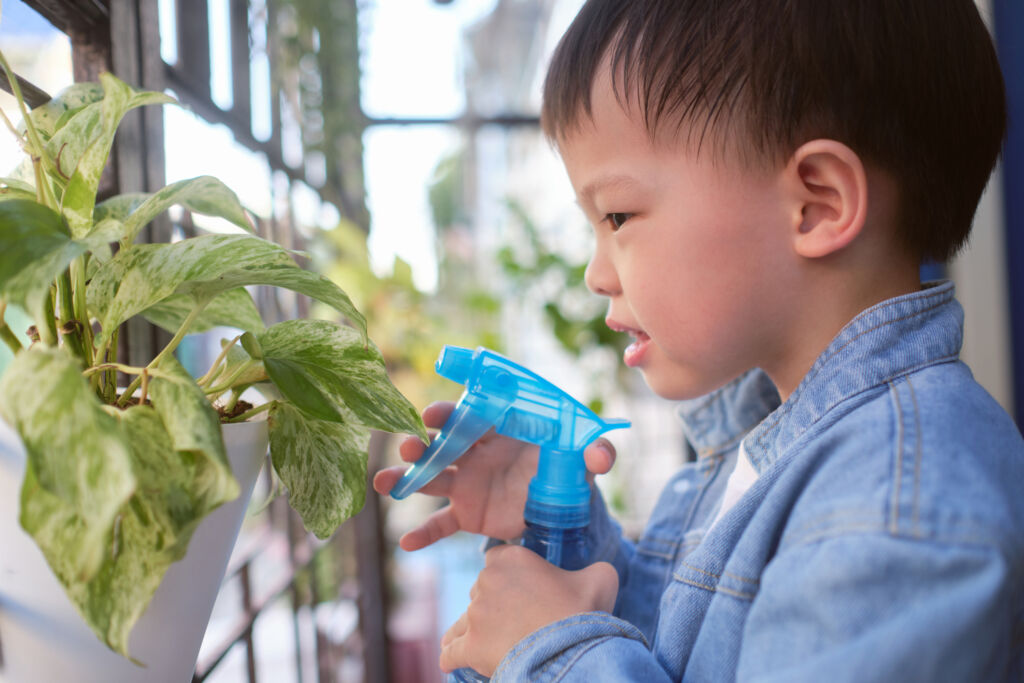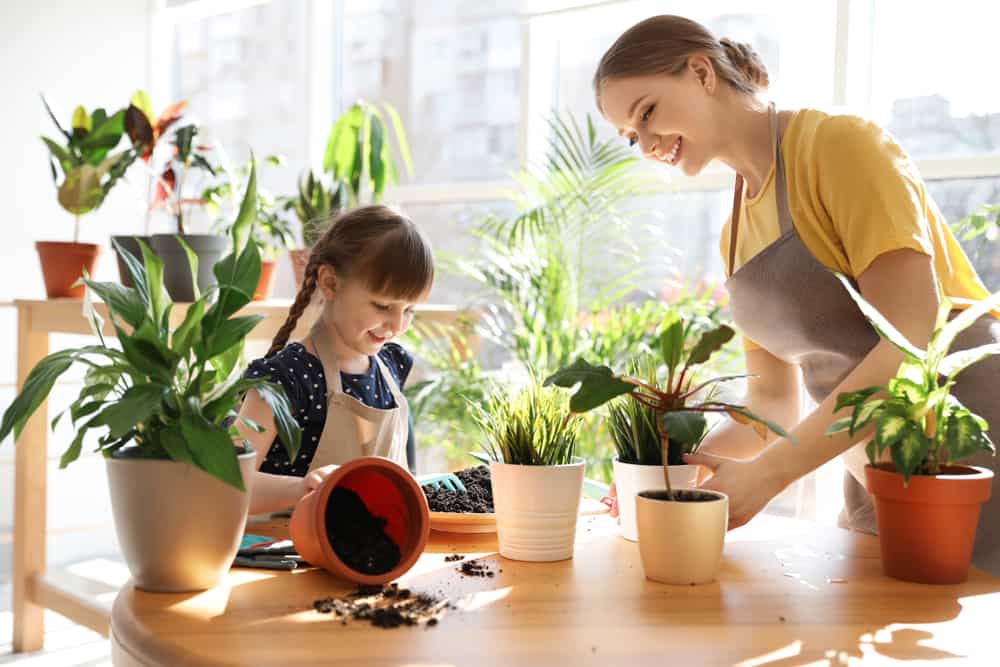HousePlantJoy is supported by our audience. When you purchase through one of our links, we may earn a small affiliate commission. As an Amazon Associate I earn from qualifying purchases. Your cost is not affected.
==================
Plants For Kids As Gifts
Parents and guardians can give plants for kids to enjoy. Small children love interacting with colors and shapes during their growing years. Shrubs, trees, and other plants offer stimulating objects to appreciate. Planting also allows for learning, developing practical attributes, and enjoyment. Still, these living things are often engaging and safe for play. Some may produce food and have other benefits, while others are quite decorative. So choosing plants as presents for young people is a good idea.
This article shares at least seven plants to give kids for education and fun. Included are pointers for teaching kids about plants and how to grow. Hence, stick around to discover the perfect gifts for your children.
Ideal Plants For Kids
There are many plants to give kids in their preadolescent or adolescent stages. Several of those for indoor and outdoor settings have appealing qualities. They are often attractive to parents and their children. Also, they are not difficult to handle due to their undemanding character. Aside from having visual appeal, they can also often manage. They become beautiful after maturing, and some produce tasty crops or gorgeous blooms. Still, a few are convenient to clean, cut, and propagate. So not all plants will overwhelm kids.
Below are some of what plant lovers impart to their kids and children. They make thoughtful presents to show gratefulness and for special occasions. Some have edible yields, while others produce showy blossoms. Most have attractive foliage, herbaceous or woody stems, and manageable roots. Thus check them to see some charming, productive, and adaptable plants.
Venus Flytrap
Also called Dionaea Muscipula, it’s one of the carnivorous plants for kids to handle. Their slow growth may make them an item of curiosity for children. It may take two to four years to see them at four inches. But it’s good since in that way they can teach people patience. They come with hinged lobes that trap prey insects when they come too close. The middle of these trigger leaves has hair-like structures called trichomes. They eat bugs to gain more nutrients than what the soil provides. Taking care of them isn’t hard since they don’t demand fertilizer and can thrive in full sun. So youngsters may appreciate having them around.
It can survive when it’s on acidic and damp soil. Yet it cannot withstand too much water. Also, when watering it, giving it distilled water is the key to hydrating it. Tap water may be alkaline or have too many elements. Such is not suitable for the plant. Also, it can stay in terrariums indoors. It should manage as long as it’s near windows, open areas, or artificial light sources. Warm areas shouldn’t be an issue for it. Plus, their leaves may shut when touched but won’t cause injuries. Thus they are safe to raise, and youngsters can consider them pets. It’s why folks treat them as excellent plants to give kids too.
Cherry Tomato
Its many beneficial characteristics allow it to belong to the ideal plants for kids. In Spanish, people call it Solanum Lycopersicum Var. Cerasiforme. The fruits it yields look like cherries due to their size and shape. Also, they have sweet, tangy, and balanced tastes, like regular tomatoes. The plant has a high yield rate and often produces fruits after two months. Some even harvest after a month and a half. Loose, quick-draining, and acidic soil can let it grow and produce edible fruits. It also does well with six to eight hours of direct sunlight. Because of its ability to grow indoors and outdoors, it’s adaptable. Hence, it belongs to those ideal plants to give kids starting gardening.
In summer, these grow fast. They absorb a lot of sunlight and respond well to various kinds of fertilizer. Due to its high yield rate, they enjoy plant food with plenty of nitrogen. It needs water every two to three days, yet this isn’t an issue. Letting children care for it allows kids to take responsibility and gain rewards. After all, they are low-maintenance but can’t take neglect. The fruits it produces are more than delicious. They are rich in antioxidants like lycopene and other beneficial elements. Thus giving this means imparting a plant that promotes good health too.
Aloe Vera
With adult direction, it can be part of the plants for kids to manage. This plant is a succulent with green foliage arranged in concentric circles. Folks appreciate these structures due to their medicinal value. The sap within them can treat wounds and sunburns. Also, the beneficial leaves come with a few white pigmentations on the surface. A few sharp spines are also on the leaf edges. But children can take care of them with supervision. Kids can raise them in pots and propagate them by cutting the leaves. The foliage is edible with its vitamins, minerals, sugars, and other content. Adding it can give certain dishes a refreshing taste. Thus it’s one of the worthy plants to give kids early.
Being succulents, it asks for deep yet infrequent watering. Schooling children may still handle it despite their busy schedules. The topsoil must be dry before the succeeding hydration. Besides, it’s easy to tell when it’s dehydrated. When that happens, it will have droopy and wilted leaves. It requires balanced fertilizer and several hours of sunlight from spring to summer. When indoors, it can stay where it’s warm and withstand rooms with 40% relative humidity. Spraying, wiping, or trimming removes pests. These activities are also not frequent affairs. Hence, kids may appreciate it as well as many adults do.
Pitcher Plant
This carnivorous plant has noticeable structures and activities. Plus, looking after it won’t demand a lot from a person. It’s these characteristics that make people consider them plants for kids. It doesn’t need fertilizer since it feeds on insects. Bugs draw near the leaves when it’s hanging on containers due to the smells it emits. It also has a peculiar veined leaf structure resembling a jug with a lid. These parts trap insects that enter and nourish the plant. Sometimes, it also digests small salamanders and other creatures that can’t escape. Likewise, it’s a rare plant. So kids may find it easy to appreciate due to its activity and rarity.
Some sell it for $5, while others charge a higher price. In any case, it’s uncommon to see it in most households. Hence, it belongs to plants to give kids who want unique vegetation. It likes some misting and when its soil gets moist. Yet it can handle a bit of dryness for a day or two. Also, it can grow well with morning and afternoon light. Yet it does best in shaded spots and away from bright summer lights. Still, they can grow in spaces with medium to high humidity. So it explains why youngsters appreciate its company.
Snake Plant
Kids may find it ridiculous and funny because of its name. But for that reason, some parents may impart a few of these plants for kids to enjoy. Even if its shape doesn’t remind you of a snake, it has many attractive features. It has upright and variegated foliage with green and yellow hues. These parts release oxygen at night. So they make the atmosphere cozy and clean altogether. Children may love having it in their bedroom due to the colors they add and the fresh air it brings. Its hardiness also makes it a choice for many homeowners. Since it doesn’t call for constant attention, kids who study in school can manage it. Hence, parents can try putting this plant indoors for kids to grow.
They are not plants to give kids who nibble. Because of the saponins present, their parts are not edible to humans and animals. Despite this, having one is a good idea. It can thrive in spaces with some drought, average humidity, and low light. Thus it can decorate shaded spots indoors without demanding too much from people. Still, it gets bigger by four to twelve inches every year. Their growth is slow, but children who treasure plants will like having them around. After all, parents and kids find their story, look, and care requirements appealing.
Pothos
Some may find its other name odd or intimidating. It’s because it goes by Devil’s Ivy. But people also call it Epipremnum Aureum. Its name is due to its ability to remain green despite staying in the dark. Also, it has heart-shaped and colorful foliage. The variegated leaves show streaks or blotches of green, yellow, and white. Plus, it’s a hardy plant. It does well when there’s bright indirect sunlight. Yet it can withstand medium to low light areas. It requires balanced fertilizer during warm months, and such plant food is easy to find. It’s also a fast grower that doesn’t demand constant watering and can handle low humidity. Because of its appeal and simple requirements, kids may find it alluring.
Its stems and leaves have traces of Calcium Oxalate, and such an attribute makes it toxic somehow. But, with guidance, they can be safe for children. There should be no health issues as long as no one ingests its stems and foliage. It can survive beside windows or shaded spots in a vase or suspended from a hanging container. It’s one of the plants to give kids an entertaining story. So, for various reasons, children can also see it as an attractive and valuable plant.
Rubber Plant
It may be toxic to pets, but it’s safe for kids to interact with it. Children can appreciate this plant with its large, green, and waxy leaves. Plus, it stands upright and may become tall when left to grow. Because of its features, kids may show it off to their peers. For good reasons, it makes the young and old proud. After all, other than displaying decorative leaves, it is easy to manage. Once in a humid area with bright indirect sunlight, it can grow with little attention. Watering it once per week or every two weeks will suffice. Plus, it’s expressive in that its foliage will droop with overwatering. So kids can take responsibility for making it grow.
Many include it in the plants to give kids due to its usefulness. Its big and thick leaves clean the air. With it, a room can be free of allergens and other toxic elements. Also, children can enjoy its company due to its conversion of carbon dioxide to oxygen. It means that fresh air can circulate indoors when it’s around. Plus, it may survive in shaded areas near windows. Thus it doesn’t need to go outdoors to get sunlight. It’s excellent for kids, considering it grows tall fast after two seasons. Since it requires trimming to control it, adults may need to help their kids take care of it.
Benefits Of Plants For Kids
Planting is a rewarding activity not only for adults but also for small children. For instance, growing crops encourages them to have a healthy diet. The act of planting is an engaging activity. It makes mental and physical exercise possible. For youngsters, it helps develop fine motor skills and self-confidence. Growing plants also enhance their focus, memory, and analytical skills. Still, the task allows room to improve mood and feel happiness. So having plants to give kids is beneficial in many aspects.
Being around plants makes children healthier too. These living beings absorb toxins and make the air breathable. Some give pest protection, while others improve room humidity. Their presence also encourages getting in touch with nature and spending time together. Gardening can also be fun when aspects of it become entertaining for kids. Still, plants teach kids to be patient and the concept of reward. After all, appropriate measures and constant effort make people raise lasting plants. Hence, children could enjoy caring for one or several.
Teach Planting and Give Plants For Kids
Plants to give kids meaningful and fun times are often fascinating and easy to handle. Giving them any of these is beneficial, but it’s when they can pay attention and commit to caring for them. Hence, when giving children shrubs or trees, make it simple. Start with small ones that are easy to appreciate and manage. Ensure they also know where their positive efforts can lead when success comes. It means choosing plants that could let them focus and produce quality yields. Try giving them essential and appropriate gardening tools. It will encourage them to grow plants because they have most items or everything they need. Even when these are available, supervise them. It’s natural for children to become distracted. Thus they need guidance when they have plants and in taking care of them.
If possible, bring them to a farm nearby to let them see how grown-ups cultivate plants. Driving them to the closest farmer’s market may also give similar benefits. They may find gardening fascinating when they know where their food originates. Being around farmers may also promote a deeper understanding of planting in general. Letting them taste fruits and vegetables is encouraging too. The same benefit comes from letting them see attractive plants and flowers. So gardening exposure, application, and guidance are crucial to let kids plant. Besides, they could be smart and a survivalist when they get into gardening at an early age.
To Conclude
Plants for kids are available for parents to buy and use to provide supervised education. Also, they are worth it as living things that make a home a healthy dwelling place. These plants are often small, simple, and productive. But it may be challenging to get some children interested in them. Kids may focus on many things, and this is the issue. But they will like plants and gardening when they become valuable in their eyes. Hence, it’s up to adults to be encouraging or supportive. Besides, many of these plants are hardy, inexpensive, exotic, and can take some neglect. Thus offering them as gifts can let you show that you care.
We hope you enjoyed reading our post about plants for kids. Please share your thoughts with us if you have other species to recommend. We’d like to hear what our readers have to say. Thanks for reading, and good luck finding the right plants for your children!

